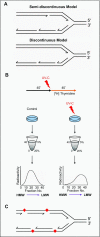Repriming DNA synthesis: an intrinsic restart pathway that maintains efficient genome replication
- PMID: 33744934
- PMCID: PMC8136793
- DOI: 10.1093/nar/gkab176
Repriming DNA synthesis: an intrinsic restart pathway that maintains efficient genome replication
Abstract
To bypass a diverse range of fork stalling impediments encountered during genome replication, cells possess a variety of DNA damage tolerance (DDT) mechanisms including translesion synthesis, template switching, and fork reversal. These pathways function to bypass obstacles and allow efficient DNA synthesis to be maintained. In addition, lagging strand obstacles can also be circumvented by downstream priming during Okazaki fragment generation, leaving gaps to be filled post-replication. Whether repriming occurs on the leading strand has been intensely debated over the past half-century. Early studies indicated that both DNA strands were synthesised discontinuously. Although later studies suggested that leading strand synthesis was continuous, leading to the preferred semi-discontinuous replication model. However, more recently it has been established that replicative primases can perform leading strand repriming in prokaryotes. An analogous fork restart mechanism has also been identified in most eukaryotes, which possess a specialist primase called PrimPol that conducts repriming downstream of stalling lesions and structures. PrimPol also plays a more general role in maintaining efficient fork progression. Here, we review and discuss the historical evidence and recent discoveries that substantiate repriming as an intrinsic replication restart pathway for maintaining efficient genome duplication across all domains of life.
© The Author(s) 2021. Published by Oxford University Press on behalf of Nucleic Acids Research.
Figures



Similar articles
-
Tolerating DNA damage by repriming: Gap filling in the spotlight.DNA Repair (Amst). 2024 Oct;142:103758. doi: 10.1016/j.dnarep.2024.103758. Epub 2024 Aug 30. DNA Repair (Amst). 2024. PMID: 39236419 Review.
-
Repriming by PrimPol is critical for DNA replication restart downstream of lesions and chain-terminating nucleosides.Cell Cycle. 2016 Aug 2;15(15):1997-2008. doi: 10.1080/15384101.2016.1191711. Epub 2016 May 26. Cell Cycle. 2016. PMID: 27230014 Free PMC article.
-
HLTF Promotes Fork Reversal, Limiting Replication Stress Resistance and Preventing Multiple Mechanisms of Unrestrained DNA Synthesis.Mol Cell. 2020 Jun 18;78(6):1237-1251.e7. doi: 10.1016/j.molcel.2020.04.031. Epub 2020 May 21. Mol Cell. 2020. PMID: 32442397 Free PMC article.
-
Repriming of DNA synthesis at stalled replication forks by human PrimPol.Nat Struct Mol Biol. 2013 Dec;20(12):1383-9. doi: 10.1038/nsmb.2719. Epub 2013 Nov 17. Nat Struct Mol Biol. 2013. PMID: 24240614
-
PrimPol-Prime Time to Reprime.Genes (Basel). 2017 Jan 6;8(1):20. doi: 10.3390/genes8010020. Genes (Basel). 2017. PMID: 28067825 Free PMC article. Review.
Cited by
-
The Response of the Replication Apparatus to Leading Template Strand Blocks.Cells. 2023 Nov 11;12(22):2607. doi: 10.3390/cells12222607. Cells. 2023. PMID: 37998342 Free PMC article. Review.
-
USP1-dependent nucleolytic expansion of PRIMPOL-generated nascent DNA strand discontinuities during replication stress.Nucleic Acids Res. 2024 Mar 21;52(5):2340-2354. doi: 10.1093/nar/gkad1237. Nucleic Acids Res. 2024. PMID: 38180818 Free PMC article.
-
Low microsatellite instability: A distinct instability type in gastric cancer?J Cancer Res Clin Oncol. 2023 Dec;149(20):17727-17737. doi: 10.1007/s00432-023-05430-6. Epub 2023 Oct 11. J Cancer Res Clin Oncol. 2023. PMID: 37819581 Free PMC article.
-
Reversing regulatory safeguards: Targeting the ATR pathway to overcome PARP inhibitor resistance.Mol Ther Oncol. 2025 Jan 14;33(1):200934. doi: 10.1016/j.omton.2025.200934. eCollection 2025 Mar 20. Mol Ther Oncol. 2025. PMID: 39968096 Free PMC article. Review.
-
Archaeal replicative primase mediates DNA double-strand break repair.Nucleic Acids Res. 2025 Apr 22;53(8):gkaf322. doi: 10.1093/nar/gkaf322. Nucleic Acids Res. 2025. PMID: 40272359 Free PMC article.
References
-
- Gambus A., Jones R.C., Sanchez-Diaz A., Kanemaki M., van Deursen F., Edmondson R.D., Labib K.. GINS maintains association of Cdc45 with MCM in replisome progression complexes at eukaryotic DNA replication forks. Nat. Cell Biol. 2006; 8:358–366. - PubMed
-
- Lei M. The MCM complex: its role in DNA replication and implications for cancer therapy. Curr. Cancer Drug Targets. 2005; 5:365–380. - PubMed
-
- Wohlschlegel J.A., Dwyer B.T., Dhar S.K., Cvetic C., Walter J.C., Dutta A.. Inhibition of eukaryotic DNA replication by geminin binding to Cdt1. Science. 2000; 290:2309–2312. - PubMed
-
- Deegan T.D., Diffley J.F.. MCM: one ring to rule them all. Curr. Opin. Struct. Biol. 2016; 37:145–151. - PubMed
Publication types
MeSH terms
Substances
Grants and funding
LinkOut - more resources
Full Text Sources
Other Literature Sources
Miscellaneous

